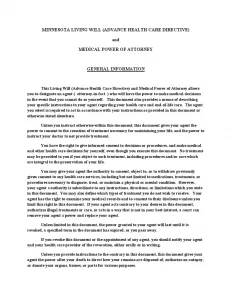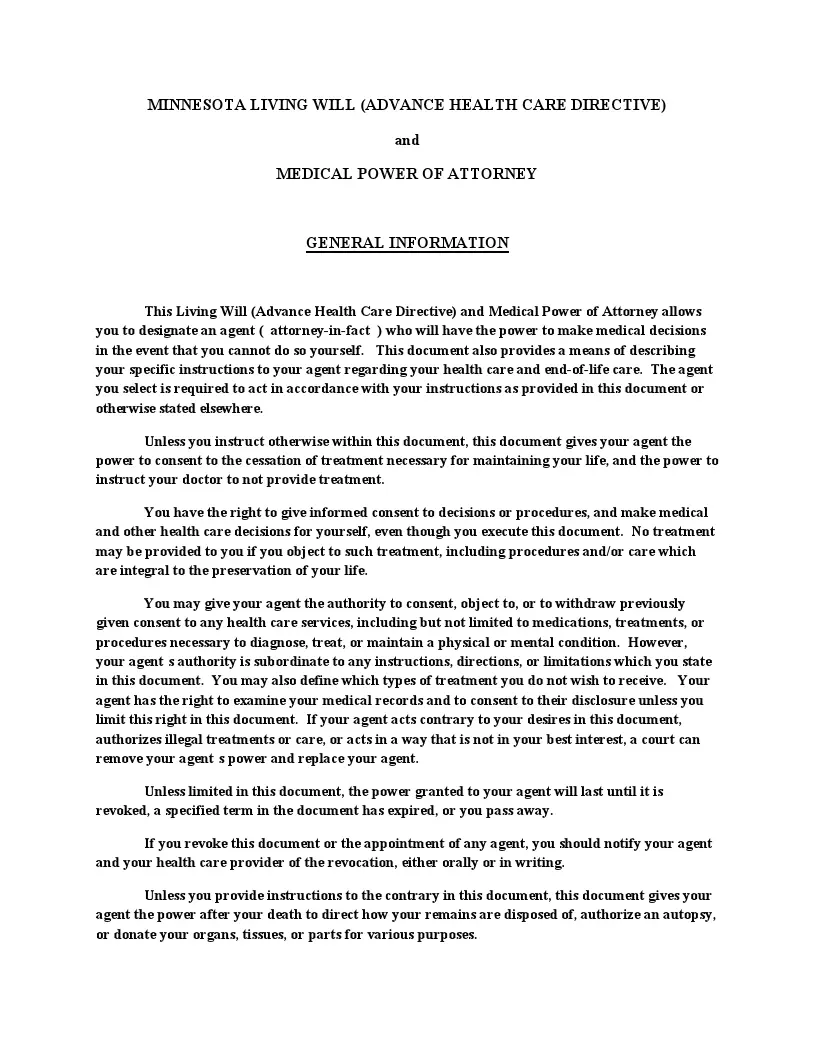Free Minnesota Living Will Form
In Minnesota, a living will is called a health care directive. This legal document outlines your medical treatment preferences if you’re unable to communicate your decisions due to illness or incapacity. The Minnesota living will must be in writing, signed, and dated while you are of sound mind. It also requires witnessing by two people who aren’t beneficiaries or health care providers, or it must be notarized.
A living will template includes statements of your values or specific medical directions, appoints a health care agent to make medical decisions and provides specific treatment instructions under certain conditions. This directive becomes effective only when your physician determines you cannot make health care decisions.
It’s essential to keep your living will accessible to your healthcare agent and primary physician and to discuss your wishes with them to ensure clarity. Regular reviews and updates of your directive are also advised to reflect any changes in your health situation or preferences.
Signing Requirements and Laws
In Minnesota, the legal framework governing the execution of a health care directive is clearly outlined in the Minnesota Statutes, specifically in Section 145C.03. This section details the requirements for a valid health care directive, ensuring that the document is legally enforceable and reflects the principal’s genuine desires regarding their medical treatment.
The principal must sign and date the directive, affirming their identity and willingness to establish such directions for their care. This action must be done while the principal is of sound mind and capable of making informed decisions about their health care.
Additional witnessing or notarization requirements further protect the integrity of the signing process:
- Witnessing. According to Section 145C.03, the health care directive must be signed by two witnesses. These witnesses must be adults, and they cannot be individuals who would stand to benefit directly from the principal’s death. Furthermore, the witnesses must not be the designated healthcare agent or providers of healthcare services to the principal.
- Notarization. Alternatively, as per Section 145C.03, the principal’s signature on the health care directive may be notarized instead of having two witnesses. A notary public will confirm the signer’s identity and ensure the signature is voluntary.
The living will must be in writing, confirming the deliberate and considered nature of the document. It should clearly state the individual’s preferences regarding medical treatments and interventions. The directive becomes effective when a physician familiar with the principal’s medical condition certifies that the individual can no longer make decisions regarding their medical treatment.
Section 145C.09 of the Minnesota Statutes outlines the process for revoking a health care directive. The principal can revoke the directive in writing or orally to a provider or agent.
Minnesota Living Will Form Details
| Document Name | Minnesota Living Will Form |
| State Form Name | Minnesota Health Care Directive |
| Signing Requirements | Two Witnesses or Notary Public |
| Validity Requirements | Section 145C.03 |
| Powers Limitation | Section 145C.07 |
| State Laws: Minnesota Statutes, Sections 145C.01 to 145C.17 | |

Steps to Fill Out the Form
Filling out the Minnesota Health Care Directive involves several steps to ensure your healthcare preferences are clearly documented and legally recognized.
1. Provide Your Personal Information
Start by entering your full name in the designated section at the top of the form. This identifies you as the directive’s principal and ensures that your health care preferences are correctly attributed to you.
2. Appoint a Health Care Agent
In Part I of the form, you can appoint a health care agent to make medical decisions. Enter the name, relationship, telephone number, and address of the person you trust to make these decisions. If you wish, you can also appoint an alternate agent who will act if your primary agent is unavailable. Fill in the details for the alternate agent as well.
3. Define the Powers of Your Health Care Agent
Specify what powers you want your health care agent to have. By default, your agent is given the authority to make all health care decisions, choose health care providers, decide where you live, and access your medical records. You must state those limitations in the space provided to limit any of these powers. Additionally, if you want your agent to have specific powers regarding organ donation and the disposition of your body after death, you must initial the appropriate lines.
4. Provide Health Care Instructions
In Part II, you can provide detailed health care instructions to guide your agent and health care providers. Outline your goals for health care, fears, spiritual or religious beliefs, thoughts on when life would no longer be worth living, and considerations for your family. Specify your preferences for medical treatments in various situations, such as if you are temporarily unable to decide, dying, permanently unconscious, or completely dependent on others for care. Additionally, you can express your wishes regarding pain relief, preferred doctors, where you want to receive care, and what should happen to your body after death.
5. Sign and Date the Document
In Part III, you must sign and date the document to make it legally binding. You can either have your signature notarized (Option 1) or witnessed by two individuals (Option 2). If using witnesses, ensure they meet the legal requirements: they must be at least 18 years old, not named as agents in the document, and only one can be a health care provider or an employee.
6. Witness Acknowledgment or Notarization
If you choose to use witnesses, they must sign and date the document, certifying that they witnessed your signature and that you appeared to be of sound mind and not under duress. Alternatively, if you opt for notarization, the notary public will confirm your identity and the authenticity of your signature.
7. Distribute Copies
Once the form is completed and signed, distribute copies to your health care agent, alternate agent, family members, primary physician, and relevant health care providers. Ensure that these individuals understand your wishes and have easy access to the directive if needed.

Below are various other Minnesota templates completed by our users. Try our simple builder to customize these forms to your preferences.
